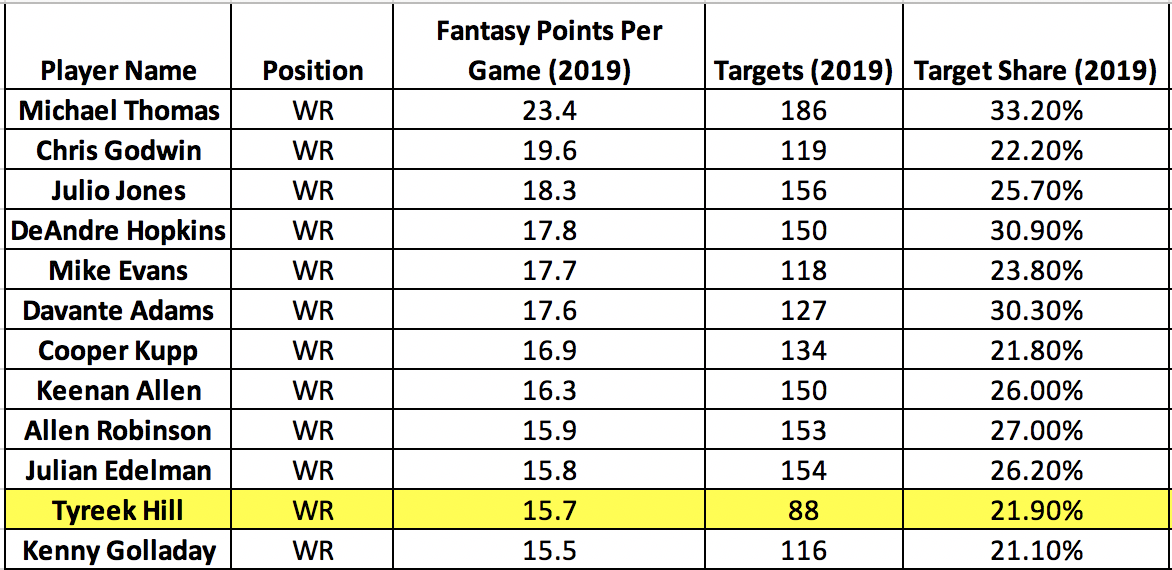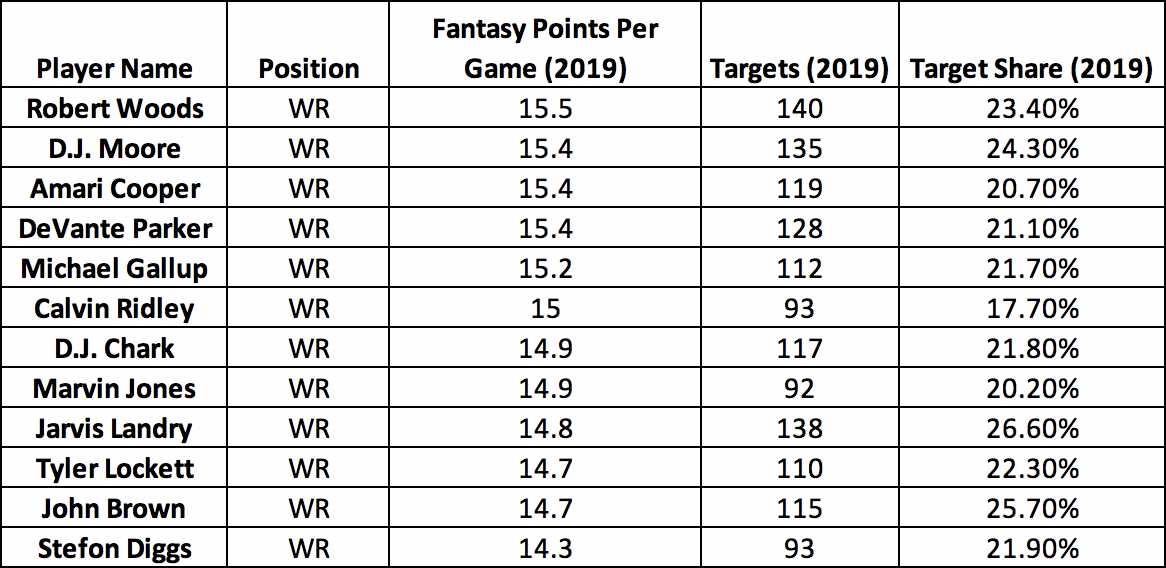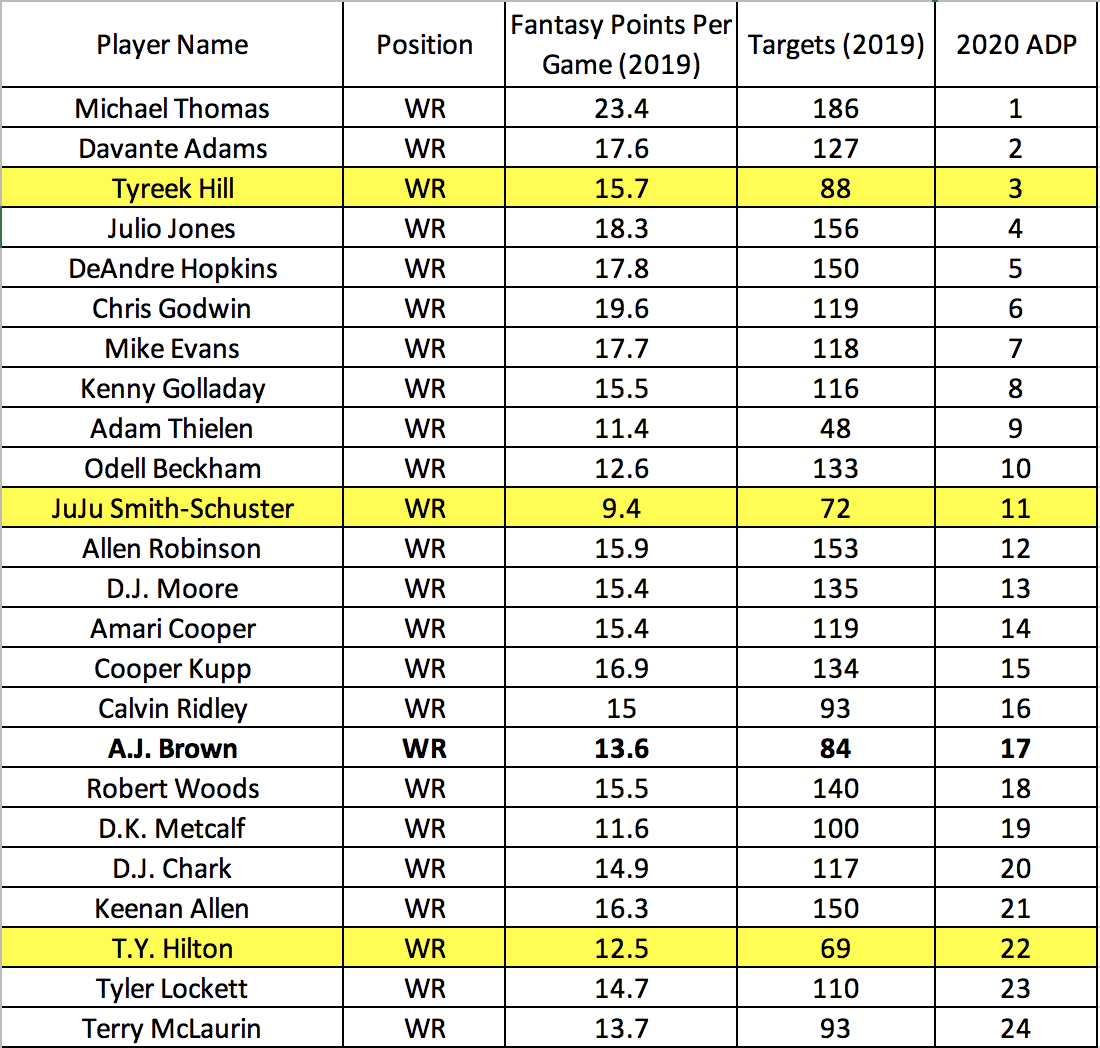Targets and opportunities matter for wide receivers. Last year, A.J. Brown ranked No. 47 among qualified wide receivers with 84 targets, only drawing a 19.5-percent (No. 41) Target Share. Yet, he’s the 16th wide receiver being drafted per FFPC ADP data. Don’t draft A.J. Brown in fantasy football redraft leagues this year. Amongst the top-12 receivers in Fantasy Points per Game in 2019, all except one received at least 116 targets. Tyreek Hill is an exception since he missed four games due to injuries. Of those other 11 receivers, eight received at least 127 targets.
Nine players in the WR2 range received 110 targets or more, with the exceptions being Calvin Ridley, Marvin Jones, and Stefon Diggs. All three finished with more targets than Brown, but the difference in ADP matters for Diggs (WR26) and Jones (WR38). Ridley (WR15) plays on the Falcons, who averaged a league-leading 45.9 pass plays per game last year. Atlanta also has the most Vacated Targets (258) coming into 2020, meaning Ridley is on track for more opportunities.
Adding to the case against Brown is that the Titans only averaged 31.5 (No. 30) pass plays per game last year. Despite what the advanced stats and metrics tell us about how efficient he was as a rookie, targets and opportunities matter, and Brown can’t be drafted at his ADP this year.
Opportunities Matter
In his 2019 rookie season, A.J. Brown recorded 52 (No. 43) catches, 1,051 (No. 21) receiving yards, and nine (No. 3) touchdowns. His low target and Target Share numbers are unsustainable, and it’s risky to trust a wide receiver with a low target share in a low-volume passing offense.
Hog Rate on PlayerProfiler indicates what players are the focal points of their team’s passing offenses. Brown wasn’t a priority target when on the field, evidenced by his 13.0-percent (No. 54) Hog Rate. Derrick Henry is the focal point of Tennesse’s offense, not Brown. Last season’s 34.7-percent (No. 4) Dominator Rating means Henry accounted for 34.7-percent of the total team yards and team touchdowns on offense.
Ever since Henry entered the league in 2016, the Titans have favored a run-heavy offense, finishing top-12 or better in rushing attempts per game. Since Henry became the backfield leader in 2018, they’ve ranked No. 9 and No. 7 in rushing attempts per game. The offense runs through Henry, and that’s not changing anytime soon.
Fade the Efficiency
For efficiency, let’s first look at Yards per Reception and Yards per Pass Route. A.J. Brown averaged 20.2 (No. 3) Yards per Reception on a team that averaged barely over 30 pass attempts per game. That’s not sustainable, and there’s no way Brown will again be the second-most efficient receiver in YPR.
PlayerProfiler writer Ron Stewart analyzed efficiency metrics in predicting second-year wide receiver production. Stewart concluded that Yards per Pass Route within the context of targets mattered most, and argues that there’s breakout potential for Brown. His 3.46 Yards per Pass Route ranked No. 1 amongst qualified receivers last year, but he recorded a lowly 67.9-percent (No. 72) Route Participation mark.
The main concerns surround the extreme efficiency paired with a team with such little passing volume. He’ll be hard-pressed to match last year’s +52.4 (No. 1) Production Premium. He also ranked No. 4 in PlayerProfiler’s proprietary Target Premium metric. Target Premium is defined as the percentage of additional fantasy points per target that a wide receiver or tight end generates over and above the other pass receivers on his team. At first glance, whoa – Brown scored 32.7-percent more fantasy points than other receivers on the Titans. However, context matters when looking at the next best Titans receiver. Brown averaged 2.58 (No. 2) Fantasy Points per Target while the next best receiver, the unproductive Corey Davis, finished with a 1.62 (No. 61) mark.
Check out A.J. Brown’s 2020 Projection on PlayerProfiler’s “World Famous” Draft Kit:
For those keeping score at home, Brown ranked No. 2 in Fantasy Points per Target while ranking No. 47 in total targets and No. 41 in Target Share on an offense that nearly averaged the fewest passes per game. A high touchdown rate is another sign of efficiency. Brown’s 15.4-percent touchdown rate ranked as the third-highest amongst receivers with 80 or more targets. Amongst the top-10 receivers sorted by Fantasy Points per Game, Mike Evans, Chris Godwin, and Cooper Kupp finished with touchdown rates above 10-percent last year. All three received 118 targets or more. The unsustainably extreme efficiency and the opportunity metrics clash, and Brown’s ADP doesn’t reflect it.
ADP & Projections
With an FFPC ADP of pick No. 47, fantasy gamers are drafting A.J. Brown at his ceiling. Don’t do this when you can draft Calvin Ridley and Robert Woods in the same range. Both play in high-volume passing offenses and receive more targets and opportunities.
The table above shows the top-24 wide receivers by ADP, their Fantasy Points per Game, and targets. The outliers include Tyreek Hill, JuJu Smith-Schuster, and T.Y. Hilton since they all missed time due to injuries. Smith-Schuster also lost his quarterback in Week 2.
The “World Famous” Draft Kit projects Brown at 128 targets, 82 receptions, 1,130 receiving yards, and nine touchdowns. Since Derrick Henry entered the NFL in 2016, Corey Davis has the highest seasonal target total with 112 in 2018. It’s a four-year trend of low passing volume and opportunities for Titans receivers, and there’s no way that’s changing in 2020.
2020 Outlook
Over the last four years, the Titans have finished no better than No. 28 in pass attempts per game. Even if the team bumps up their pass attempts to around the 500 area, there won’t be drastic offensive changes with Derrick Henry as the lead running back. Don’t draft A.J. Brown at his ADP – opportunities and targets matter. It’s not sustainable for Brown to continue the extreme efficiency on a run-focused offense.









